
The Battle of Solferino on 24 June 1859 resulted in the victory of the allied French army under Napoleon III and the Piedmont-Sardinian army under Victor Emmanuel II against the Austrian army under Emperor Franz Joseph I. It was the last major battle in world history where all the armies were under the personal command of their monarchs. Perhaps 300,000 soldiers fought in the important battle, the largest since the Battle of Leipzig in 1813. There were about 130,000 Austrian troops and a combined total of 140,000 French and allied Piedmontese troops. After the battle, the Austrian emperor refrained from further direct command of the army.
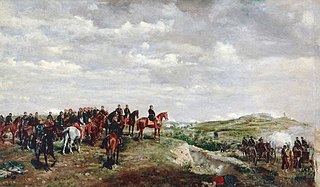
The Second Italian War of Independence, also called the Sardinian War, the Austro-Sardinian War, the Franco-Austrian War, or the Italian War of 1859, was fought by the Second French Empire and the Kingdom of Sardinia against the Austrian Empire in 1859 and played a crucial part in the process of Italian Unification.
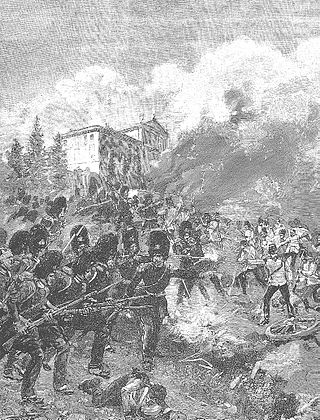
The First Battle of Custoza was fought on July 24 and 25, 1848, during the First Italian War of Independence between the armies of the Austrian Empire, commanded by Field Marshal Radetzky, and the Kingdom of Sardinia, led by King Charles Albert of Piedmont-Sardinia.

Goito is a comune with a population of 10,005 in the Province of Mantua in Lombardy. Goito is 20 kilometres (12 mi) north of Mantua on the road leading to Brescia and Lake Garda, and straddles the old east–west Via Postumia between Cremona and Verona. The town is on the right bank of the Mincio River at a key crossing. The birthplace of Sordello, Goito is part of the historic region known as Alto Mantovano and was the site of a notable fortress.

In the War of the Sixth Coalition, the Battle of the Mincio River was fought on 8 February 1814 and resulted in an inconclusive engagement between the French under Eugène de Beauharnais and the Austrians under Field Marshal Heinrich von Bellegarde. Fought on the same ground as Napoleon's victory at the Battle of Borghetto in 1796, the battle was not as decisive as Eugène hoped, and in the end it had little significant impact upon the war, whose outcome was to be decided in France rather than Italy.

Volta Mantovana is a comune (municipality) in the Province of Mantua in the Italian region of Lombardy, located about 120 km (75 mi) east of Milan and about 20 km (12 mi) northwest of Mantua.
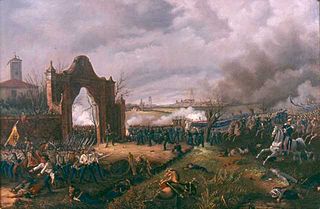
The First Italian War of Independence, part of the Italian Unification (Risorgimento), was fought by the Kingdom of Sardinia (Piedmont) and Italian volunteers against the Austrian Empire and other conservative states from 23 March 1848 to 22 August 1849 in the Italian Peninsula.
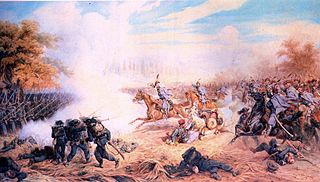
The Third Italian War of Independence was a war between the Kingdom of Italy and the Austrian Empire fought between June and August 1866. The conflict paralleled the Austro-Prussian War and resulted in Austria conceding the region of Venetia to France, which was later annexed by Italy after a plebiscite. Italy's acquisition of this wealthy and populous territory represented a major step in the Unification of Italy.

The Battle of Goito was fought between the Piedmontese and the Austrian army on 30 May 1848, in the course of the First Italian War of Independence. The Piedmontese army won the battle, as the Austrians were unable to break through to relieve the siege of Peschiera and prevent its surrender which happened on the day before the battle.

Johann Peter de Beaulieu, also Jean Pierre de Beaulieu, was a Walloon military officer. He joined the Habsburg army and fought against the Prussians during the Seven Years' War. A cultured man, he later battled Belgian rebels and earned promotion to general officer. During the French Revolutionary Wars he fought against the First French Republic and attained high command. In 1796, a young Napoleon Bonaparte won some of his first victories against an army led by Beaulieu. He retired and was the Proprietor (Inhaber) of an Austrian infantry regiment until his death.

Michelangelo Alessandro Colli-Marchi or Michelangelo da Vigevano or Michael Colli entered the Habsburg Austrian army as a commissioned officer and became a general officer after fighting in the Seven Years' War, War of the Bavarian Succession, and Austro-Turkish War. During the War of the First Coalition, he was loaned to the Kingdom of Sardinia-Piedmont for three years. In 1796, his army was defeated by Napoleon Bonaparte in a swift campaign that knocked Sardinia-Piedmont out of the war. In early 1797, he was given command of the army of the Papal States, but his troops were defeated at Faenza.
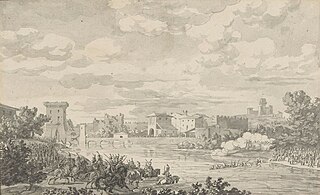
The Battle of Borghetto, near Valeggio sul Mincio in the Veneto of northern Italy, took place during the War of the First Coalition, part of the French Revolutionary Wars. On 30 May 1796, a French army led by General Napoleon Bonaparte forced a crossing of the Mincio River in the face of opposition from an Austrian army commanded by Feldzeugmeister Johann Peter Beaulieu. This action compelled the Austrian army to retreat north up the Adige valley to Trento, leaving the fortress of Mantua to be besieged by the French.
Anton Schübirz or Anton Schubirz von Chobinin was an Austrian Generalmajor. He fought for Habsburg monarchy against Ottoman Turkey and the French First Republic. He participated in several noteworthy actions during the French Revolutionary Wars. As a newly promoted general officer in Italy, he led a brigade in an all-night action against the French at Codogno, part of the Battle of Fombio in May 1796. In the sparring before the Battle of Castiglione, he showed initiative in bringing his troops to the assistance of a fellow general. He also fought at Fontaniva, Caldiero, and Arcole in the autumn of 1796. This was the theater of war where a young French general named Napoleon Bonaparte earned his fame. Schübirz retired from the army in 1798 and died three years later.

Ludwig Freiherr von Wohlgemuth was an Austrian general and commander of the Order of Maria Theresa.

The III Army Corps was one of three corps the Italian Army fielded during the Cold War. Based in the regions of Lombardy and Piedmont the corps was the army's operational reserve, while the 4th Alpine Army Corps and the 5th Army Corps, both based in the North East of Italy, were the army's front-line units. After the end of the Cold War the corps was reduced in size and on 1 December 2000 it ceded its last brigades to the 1st Defence Forces Command. The personnel of the 3rd Army Corps was used to raise the NATO Rapid Deployable Italian Corps in January 2001.

The 2nd Bersaglieri Regiment is an inactive unit of the Italian Army last based in Legnano in Lombardy. The regiment is part of the army's infantry corps' Bersaglieri speciality and was last operationally assigned to the Armored Brigade "Centauro". The regiment was formed in 1861 by the Royal Italian Army with preexisting battalions. During World War I the regiment served on the Italian front.

The Regiment "Cavalleggeri di Saluzzo" (12th) is an inactive cavalry unit of the Italian Army named for the Marquisate of Saluzzo. In 1848, Provisional Government of Milan formed two cavalry regiments for the First Italian War of Independence. In September of the same year, the two regiments joined the Royal Sardinian Army. In May 1849, the two regiments merged to form the 7th Regiment of Cavalry, which in January 1850 was renamed Regiment "Cavalleggeri di Saluzzo". The regiment fought in the Crimean War, Second Italian War of Independence, and Third Italian War of Independence. In World War I the regiment fought on the Italian Front. During World War II the regiment was assigned to the 1st Cavalry Division "Eugenio di Savoia", which was deployed to occupied Yugoslavia on anti-partisan duty. The division and its units were disbanded after the announcement of the Armistice of Cassibile by invading German forces.
The Battle of Villabuona was fought on 29 May 1630 in the frazione of Villabona in southern Lombardy during the Mantuan war of succession between an allied Franco-Venetian army led by the Venetian provveditore Zaccaria Sagredo and the French commander Duc de Candale on one side and the Imperial army of Mathias Gallas on the other. The more numerous Franco-Venetians and their Mantuan allies hoped to end the Imperial siege of Mantua but were comprehensively defeated by Gallas' smaller force, numbering perhaps 10,000 men. The defeat was tactically and strategically significant for the allies and "rendered the outcome of the siege of Mantua a foregone conclusion", leading to the collapse of the city's defenses and its infamous sack later that year.

The Battle of Volta Mantovana of 1848 was an engagement during the First Italian War of Independence fought throughout Volta Mantovana on 26 and 27 July 1848 between the Second Austrian army corps of General Konstantin D'Aspré and the 3d Piedmontese division of general Ettore De Sonnaz. It resulted in a decisive Austrian victory.
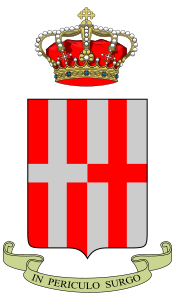
The Regiment "Cavalleggeri di Alessandria" (14th) is an inactive cavalry unit of the Italian Army named for the city of Alessandria in Piedmont. In 1850, shortly after the First Italian War of Independence, the Royal Sardinian Army formed the regiment. The regiment fought in the Second Italian War of Independence, Crimean War, and Third Italian War of Independence. In World War I the regiment fought on the Italian Front. During World War II the regiment was assigned to the 1st Cavalry Division "Eugenio di Savoia", with which the regiment deployed to occupied Yugoslavia on anti-partisan duty. On 17 October 1942, the regiment conducted the last cavalry charge in Italian military history. After the announcement of the Armistice of Cassibile on 8 September 1943, the regiment rode towards Italy, but the lack of orders and pressure by invading German forces, led to the regiment's commander ordering the regiment to dissolve on 14 September 1943.

















